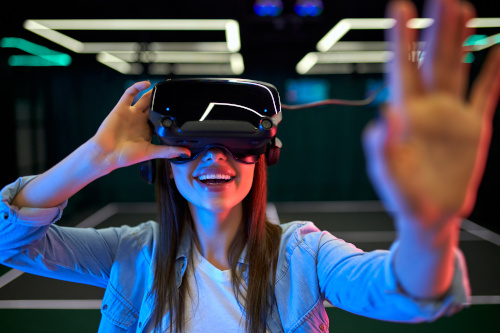We all know that augmented reality (AR) and virtual reality (VR) are super fun, but AR and VR tools can also be incredibly powerful when integrated into classroom learning.
What’s the difference? AR is the idea that the user brings something into their real world and using a device to see something that isn’t actually there–animation or 3D images come into the real world. VR immerses a person in the experience, as if they’re actually there.
AR and VR tools have a number of benefits for students, and because the tools are engaging, students are more likely to absorb classroom lessons and concepts. Plus, students are engaged in active learning with AR and VR tools.
Here’s a handful of fun and engaging AR and VR tools to get you started:
3DBear AR: This app combines immersive technologies and inspiring pedagogic content for the optimal learning results. Strategies include AR, VR, 360-photos, scanning, and 3D printing. Most of the app’s features are free.
Avanti’s World: Avanti’s World is the world’s first educational VR “theme park.” Created by Avantis Education, Avanti’s World offers an immersive and engaging educational experience where students can walk with dinosaurs, visit ancient civilizations, journey to distant planets, and experience other impossible adventures all from the safety of a ClassVR headset or a web browser. Avanti’s World is divided into four different “lands” — “Trip Through Time Land,” “Super Science Land,” Engaging Earth Land,” and “Literacy Land,” with hundreds of scenes to explore. It includes reporting and assessment tools for teachers and a comprehensive set of educational resources for each land. Students can engage in a guided lesson, learn in groups, or explore Avanti’s World independently.
Catchy Words AR: This word game was made specifically with augmented reality in mind and has been used for students with dyslexia. Students have an immersive experience without touching the screen as they walk around, catch the letters with their device, and solve the word.
ClassVR: ClassVR, by Avantis Education, is a turnkey VR solution providing engaging content for students of all ages. Unlike other VR headsets, the ClassVR headset is a standalone, classroom-ready device that does not require any additional equipment, such as phones. The new ClassVR Premium Virtual Reality Headset, offered in 8- and 30-packs, includes several new features, including a new and improved 2K HD fast switching display, a high performing Qualcomm processor made specifically for AR and VR devices, a 100 degree field of view, upgraded optics, a front facing camera and an all new body to complement the new device features. ClassVR offers hundreds of Virtual Reality resources, a web-based management portal and uses existing IT infrastructure to make it simple for teachers to integrate VR into their instruction.
FigmentAR: Users augment their reality with objects, portals, and effects. Students can create imaginative scenes and capture them to share with peers as they place 3D emoji, animals, and other objects around their augmented space. Or, students can step into another world by using portals and walking into a new dimension.
Killer Snails: Killer Snails creates immersive games that inspire a love of science. Its games are built by scientists and backed by science, and the company’s mission is to create the next generation of changemakers and to bring science out of the laboratory and into the hands of learners. The company aims to get kids–particularly girls–interested in STEM careers. One of the company’s newest products, BioDive!, is an immersive dual virtual reality/digital experience where players are marine biologists investigating the delicate ecosystems of venomous marine snails. Throughout their expedition, students observe, discover, and hypothesize about abiotic and biotic factors that impact marine biodiversity.
Story Spheres: Users upload a 360-degree image, add sounds or triggered hotspots, and embed the Story Sphere on a website for a fully digital storytelling experience. Story Spheres has been used by journalists, documentary makers, wildlife activists, artists, educators, and small businesses to tell stories that truly revolve around their audiences.
JigSpace: This tool lets students create AR presentations. For example, an engineering teacher might pull up a relevant object and use it to explain an engineering concept to students via AR.
Kai’s Clan: Kai’s Clan is a collaborative coding platform that encompasses several technologies into an all-in-one learning platform. Robotics, AR, VR, Internet of Things (IoT) and Artificial Intelligence are more than just current trends–they are important tools for preparing students for the Fourth Industrial Revolution and Kai’s Clan incorporates all these tools into an all-in-one platform.
Oculus Rift: This is a truly immersive experience in which users wear a headset and hold controllers. It’s an expensive option but offers a powerful experience. More education content is being created for students and teachers.
- Friday 5: How esports engages students - March 22, 2024
- Friday 5: The pivotal role of school libraries - March 15, 2024
- DEI in action: eSN Innovation Roundtable - March 13, 2024


